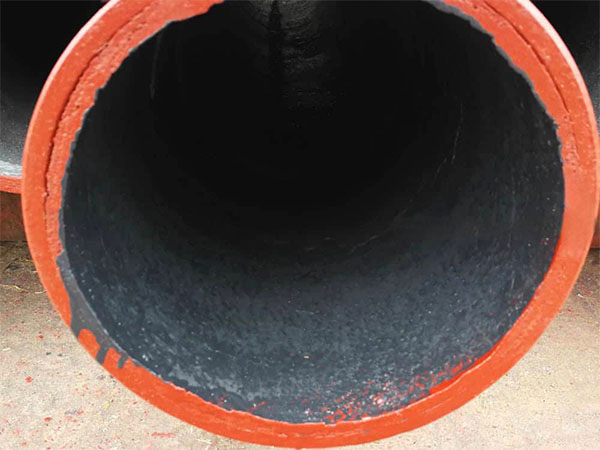Ceramic lined carbon steel pipe is a kind of composite pipe that combines the mechanical properties of carbon steel with the excellent wear resistance and corrosion resistance of ceramics, and is widely used in harsh working conditions. The following is a detailed introduction to it:
Definition and Structure
Ceramic lined carbon steel pipe is a kind of composite pipe, which is composed of a carbon steel matrix and an internal wear-resistant ceramic layer. Its structure can be divided into three layers:
The inner ceramic (usually Corundum,α-Al₂O₃), with a thickness typically ranging from 3 to 10mm, has a hardness as high as HV1100 to 1500, equivalent to tungsten-cobalt hard alloy, and can withstand extremely high wear.
Transition layer: Ensures the strong and tough bond between the steel pipe and the ceramic.
Outer carbon steel pipe: It provides the overall mechanical strength and weldability of the pipe.

Manufacturing process
Centrifugal casting method: Ceramic powder is mixed with a binder and injected into a rotating steel pipe. It is evenly distributed by centrifugal force and then sintered and solidified at high temperature.
Self-propagating high-temperature synthesis (SHS) : By generating high temperatures through an aluminothermic reaction, ceramic materials are in-situ synthesized on the inner wall of steel pipes, achieving high bonding strength.
Thermal spraying technology: Ceramic materials are melted and sprayed onto the inner wall of steel pipes, suitable for complex shapes.
Adhesive method: Use high-temperature resistant adhesives to fix ceramic plates or ceramic rings. It has a low cost but limited heat resistance.
Performance characteristics
Extremely high wear resistance: Compared with ordinary carbon steel pipes, the service life can be increased by more than 20 times. In the transportation containing hard particles, the volume loss of the ceramic layer was only 0.0022cm³ (sand particle scouring test).
High mechanical strength: Hoop strength 300-500MPa, compressive shear strength 15-20MPa.
Excellent thermal shock resistance: After being heated at 800℃ and quenched in water, the ceramic layer still shows no peeling or cracking.
Corrosion resistance: Corundum is chemically inert and has excellent resistance to acids, alkalis and various chemical media.
Good weldability: Only conventional welding is carried out on the outer layer of carbon steel, and the weld seam can be repaired with epoxy mortar or ceramic lining.
Lightweight and convenient: It is 20-50% lighter than alloy pipes, cast stone pipes and bimetallic composite pipes, reducing transportation and installation costs.
Typical application
Mining and mineral processing: Transporting coal powder, slurry, tailings and mortar, wear-resistant, erosion-resistant, and extending the service life of pipelines.
Metallurgy and steel: Conveying iron ore, coke powder, slag and high-temperature flue gas ash, with high-temperature resistance and corrosion resistance.
Power industry: Coal powder conveying pipelines in thermal power plants, as well as sand and gravel conveying in circulating water systems.
Chemical engineering and petrochemicals: Conveying highly abrasive chemical slurries and corrosive media.
Papermaking industry: Pulp conveying pipelines, resistant to acid, alkali and fiber wear.
Grain, oil and building materials: Conveying silica sand, cement slurry, fly ash and various granular materials.
Installation and maintenance
Welding protection: During construction, the inner lining should be shielded when welding. If welding slag splashes, the ceramic layer should be repaired in time.
Lining inspection: The thickness of the lining and the interlayer bonding strength can be inspected by ultrasonic or radiographic means. Cracks and delamination can also be inspected with a CCTV endoscope.
Repair method: After cleaning the local damaged area thoroughly, spray or brush on the special ceramic mortar and keep it wet for more than 4 days.
Installation: Avoid knocking or welding. Use flange connection. Special diamond tools are required for cutting.
Maintenance: Regularly inspect the wear of the inner lining. Local damage can be temporarily repaired with ceramic repair glue.
Ceramic-lined carbon steel pipes, with their outstanding performance, have replaced traditional materials in areas with severe wear and strong corrosion, becoming an important choice for the upgrading of industrial pipelines. Correct selection and application can maximize its economic benefits.
